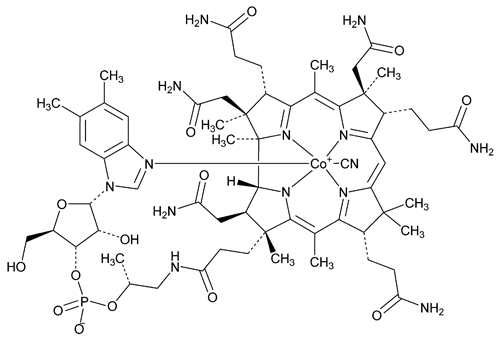Cyanocobalamin
(sye'' an oh koe bal' a min).
DEFINITION
Cyanocobalamin contains NLT 96.0% and NMT 100.5% of cyanocobalamin (C63H88CoN14O14P), calculated on the dried basis.
IDENTIFICATION
• A. Ultraviolet Absorption  197U
197U
Wavelength range: 200–700 nm
Sample solution: Prepare as directed for Sample solution in the Assay.
Acceptance criteria: The absorption spectrum exhibits maxima at 278 ± 1 nm, 361 ± 1 nm, and 550 ± 2 nm. The absorbance ratio A361/A278 is 1.70–1.90, and the absorbance ratio A361/A550 is 3.15–3.40.
• B.
Sample solution: Fuse 1 mg of Cyanocobalamin with 50 mg of potassium pyrosulfate in a porcelain crucible. Cool, break up the mass with a glass rod, add 3 mL of water, and dissolve by boiling.
Analysis: Add 1 drop of phenolphthalein TS, and add sodium hydroxide solution (100 mg/mL), dropwise, until just pink. Add 500 mg of sodium acetate, 0.5 mL of 1 N acetic acid, and 0.5 mL of nitroso R salt solution (2 mg/mL).
Acceptance criteria: A red or orange-red color appears at once. Add 0.5 mL of hydrochloric acid, and boil for 1 min: the red color persists.
• C.
Sample solution: Dissolve 5 mg of Cyanocobalamin in 5 mL of water in a 50-mL distilling flask connected with a short, water-cooled condenser. To the flask add 2.5 mL of hypophosphorous acid, close, and boil gently but short of distillation for 10 min. Then distill 1 mL into a test tube containing 1 mL of sodium hydroxide solution (20 mg/mL).
Analysis: To the test tube add 4 drops of cold saturated ferrous ammonium sulfate solution, shake gently, then add 30 mg of sodium fluoride, and bring the contents to a boil. Immediately add, dropwise, 5 N sulfuric acid until a clear solution results, then add 3–5 drops more of the acid.
Acceptance criteria: A blue or blue-green color develops within a few min.
ASSAY
• Procedure
Standard solution: 30 µg/mL of cyanocobalamin from USP Cyanocobalamin RS in water
Sample solution: 30 µg/mL of Cyanocobalamin in water
Instrumental conditions
Mode: UV
Analytical wavelength: 361 nm
Cell: 1 cm
Blank: Water
Analysis
Samples: Standard solution and Sample solution
Calculate the percentage of cyanocobalamin (C63H88CoN14O14P) in the portion of Cyanocobalamin taken:
Result = (AU/AS) × (CS/CU) × 100
| AU | = | = absorbance of the Sample solution |
| AS | = | = absorbance of the Standard solution |
| CS | = | = concentration of cyanocobalamin in the Standard solution (µg/mL) |
| CU | = | = concentration of Cyanocobalamin in the Sample solution (µg/mL) |
Acceptance criteria: 96.0%–100.5% on the dried basis
IMPURITIES
• Pseudocyanocobalamin
Sample solution: 0.05 mg/mL of Cyanocobalamin in water
Analysis: Transfer a 20-mL portion of the Sample solution into a small separator. Add 5 mL of a mixture of carbon tetrachloride and m-cresol (1:1), and shake well for about 1 min. Allow to separate, draw off the lower layer into a second small separator, and add 5 mL of 5 N sulfuric acid. Shake well, and allow to separate completely. [Note—The complete separation of the layer may be facilitated by centrifuging. ]
Acceptance criteria: The separated upper layer is colorless or has no more color than a mixture of 0.15 mL of 0.10 N potassium permanganate and 250 mL of water.
SPECIFIC TESTS
• Loss on Drying  731
731 : Heat 25 mg in a suitable vacuum drying apparatus at 105
: Heat 25 mg in a suitable vacuum drying apparatus at 105 and at a pressure of NMT 5 mm of mercury for 2 h. Cool, and weigh: it loses NMT 12.0% of its weight.
and at a pressure of NMT 5 mm of mercury for 2 h. Cool, and weigh: it loses NMT 12.0% of its weight.
ADDITIONAL REQUIREMENTS
• Packaging and Storage: Preserve in tight, light-resistant containers, and store at controlled room temperature.
Auxiliary Information— Please check for your question in the FAQs before contacting USP.
| Topic/Question | Contact | Expert Committee |
|---|---|---|
| Monograph | Huy T. Dinh, M.S. Scientific Liaison 1-301-816-8594 | (DS2010) Monographs - Dietary Supplements |
| Reference Standards | RS Technical Services 1-301-816-8129 rstech@usp.org |
USP35–NF30 Page 2783
Pharmacopeial Forum: Volume No. 31(5) Page 1350
